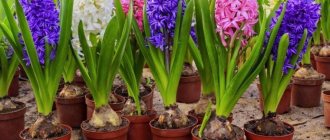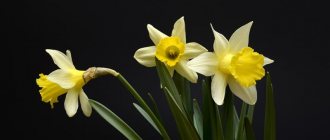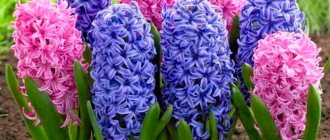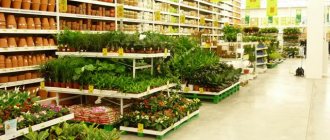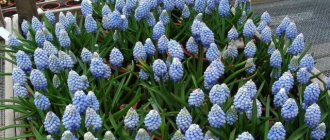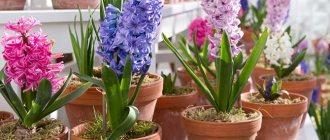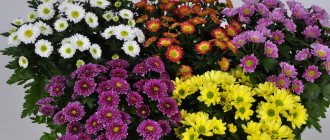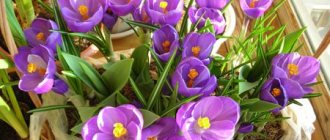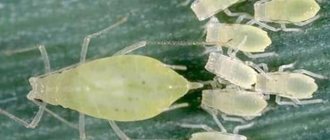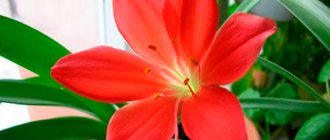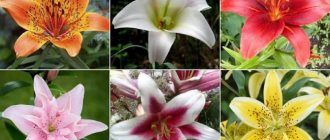Hyacinth is a bulbous plant with bright and fragrant flowering in early spring.
The flower is unique in that it can be successfully grown both in open ground and as an indoor flower that can be made to bloom at a certain time. Familiarity with the characteristics of a flower's growing season will help you learn how to grow at home and how to care for a plant.
Types of hyacinth
The genus Giacint unites only 3 species:
- hyacinth Oriental;
- hyacinth Litvinova;
- hyacinth Transcaspian.
In decorative floriculture, only Eastern hyacinth , characterized by:
- a dense, fleshy bulb, the color of the upper layer of scales of which, in its basic tone, correlates with the shade of the petals ;
- rosette leaves of linear or elongated oval shape with a pointed apex ;
- an erect peduncle rising to a height of up to 30 cm and bearing a racemose fragrant inflorescence formed by flowers with dense bell-shaped corollas.
Popular varieties for indoor growing
Based on Eastern hyacinth, numerous hybrids , the descriptions of which differ:
- structure of the corollas: simple and terry ;
- petal color: white, yellow, orange, blue and purple, pink, red and black;
- Flowering dates: early, mid and late blooming.
Oriental hyacinth hybrids are unusually decorative; the Internet is replete with numerous photos of them. Most are suitable for growing indoors . The most common varieties found at home are:
- Ostara, with high (up to 30 cm) peduncles and loose purple inflorescences about 13 cm long, maintaining freshness for 3 weeks.
- Rosalia, different pink shades of inflorescences, consisting of 15-17 small (diameter 2 cm) buds with a short flowering period.
- Sunflower, with peduncles up to 20 cm high and medium-density cream inflorescences formed by small (3.5 cm) double flowers. Blooms for 2 weeks.
- Amethystcharacterized by a light purple color dense inflorescences up to 10 cm long and a one-week flowering period.
- La Victoire, which have gained popularity thanks to their dense inflorescences of spectacular bright red tones.
Home care
In order to understand whether and how to grow hyacinth in an apartment , you need to get acquainted with the peculiarities of flower development.
The life cycle of hyacinth consists of 2 phases:
- the period of active growth occurring in spring and accompanied by the growth of leaves and flowering;
- a dormant period that occurs after flowering and lasts throughout autumn and winter. At this time , the ground part of the plant dies off , the flower exists at the level of the bulb.
In each period, hyacinth needs to create certain conditions and proper care.
Location and lighting
Hyacinth is a light-loving plant . For a successful growing season, it needs at least 15 hours of daylight, so at home it is better to place the flower on windows facing south or southeast .
On a sunny summer afternoon, the plant is darkened; in cloudy weather, as well as in early spring, it is additionally illuminated using phyto or fluorescent lamps .
During rest, the plant does not need light.
Temperature
One of the main conditions for optimal development and high-quality flowering of hyacinth is compliance with the temperature regime :
- during the active growing season, the flower needs moderate heat - 20, maximum 23 ° C ;
- complete rest, accompanied by the laying of flower buds, is possible only in cool weather - 15-17 degrees Celsius.
Attention! Hyacinth is sensitive to sudden temperature fluctuations and does not tolerate proximity to heating devices and the presence of drafts.
Watering and air humidity
Hyacinth loves water very much, so the soil in its pot should be slightly moist .
In indoor conditions, the plant is watered with water at room temperature that has been standing for 24 hours, rain water, or slightly warmed melt water.
The soil is moistened carefully , along the edge of the pot or from below, through a tray, trying not to get on the bulb, in the axils of the leaves and on the buds.
Important! With all their love for moisture, hyacinths grow only in an atmosphere of dry air and do not tolerate spraying.
The soil
To develop the bulb, hyacinth needs a nutrient substrate with a neutral environment, which can be used as a purchased universal flower soil or a mixture made independently.
Several options for its composition are possible:
- equal parts of humus or compost, peat, sand, leaf and turf soil;
- garden soil, peat and sand, taken in equal quantities;
- 2 parts of turf land, combined with 1 part of sand and one part of peat.
Experienced gardeners recommend adding perlite or vermiculite , which retain moisture and promote soil aeration.
Before planting, the soil is disinfected using one of the available methods:
- spill with a solution of phytosporin or potassium permanganate of medium concentration;
- calcined for half an hour in the oven;
- steam for 30 minutes.
Important . Preliminary soil treatment will avoid damage to the bulb by soil pests and reduce the risk of fungal diseases.
Feeding and fertilizers
Beautiful flowering of hyacinths is impossible without regular application of fertilizers , which use complex mineral additives for flowering or bulbous plants:
- fertilizing begins when the leaves grow, introducing mineral additives containing an increased amount of nitrogen ;
- in the future, until the end of flowering, fertilizers are applied 2 times a month , always after watering.
Advice! At the budding stage and during flowering, one of the fertilizers is replaced by adding a drug that stimulates flowering.
Reproduction
There are several methods for propagating hyacinths:
- seeds – used in breeding work;
- leaves - a labor-intensive, inconvenient and unpopular method;
- by children - separated from the mother bulb, planted separately, plants are obtained from the second year;
- bulbs - initially using purchased material, this is the most common and affordable method;
- By cutting out the bottom of the bulb, a large number of large, viable children are achieved. They are subsequently planted to produce new hyacinths.
Gardeners recognize the method of cutting out the bottom of the bulb as the most promising and fastest . The method is relatively simple and accessible even to inexperienced gardeners.
Choosing a bulb and forcing hyacinths
When grown artificially, hyacinth can be forced to bloom on a specific date . This process is called forcing. To carry it out, it is necessary to purchase and prepare planting material, substrate and containers in advance.
For forcing, extra-class bulbs are used , which differ in:
- large (from 5 cm in diameter) sizes;
- density;
- smooth surface without dents or bulges;
- uniform coloring of the scales, eliminating the presence of stains, inclusions and plaque .
The forcing bulb should have a small (1.5 times smaller than the diameter of the bulb) smooth and dry bottom , indicating its youth, and the rudiment of a cone-shaped sprout.
- Preparation of planting material: before planting, the bulbs are soaked for 1-2 hours in a weak solution of potassium permanganate, phytosporin (1 teaspoon per liter of water at room temperature) or any fungicide (Maxim, Vitaros), and then dried. After this, the bulbs are placed for 2 or weeks in a cool (5-7, maximum 8 ° C) place, for example, on the bottom shelf of the refrigerator.
- Containers: it is convenient to force hyacinths in small plastic pots 10-12 cm high, with drain holes and a drainage compartment. Clay and ceramic containers are not suitable, since the porous structure of their walls contributes to rapid cooling of the soil, which can lead to rotting of the bulb.
- The composition of the soil is selected based on the grower’s plans:
- a bulb used only for forcing can be planted in any substrate capable of holding roots. For a single flowering, its supply of nutrients is sufficient;
- in all cases involving the use of bulbs after forcing, planting is carried out in a nutrient mixture .
Forcing at home: step-by-step instructions
The process of home forcing of hyacinths is carried out according to the following scheme:
- Planting: the container is filled with substrate, leaving 1-1.5 cm to the edges , one or several (3-5 pieces) bulbs are placed on its surface at a distance of 1.5-2 cm, slightly (no more than 2/3) pressing bottom into the soil.
- Watering: carried out immediately after planting, along the edge of the pot or from below, through a tray; water should not fall on the bulb. If the soil settles after watering, top it up.
- Rooting: for the growth of roots and leaves, hyacinths need coolness and darkness , so the container with the bulbs is covered with thick dark paper and placed in a cool (5-9 degrees above zero) place for 40-45 days. Periodically, the containers are inspected and the soil is checked for moisture. It should not be allowed to dry out or become waterlogged . During this time, the flower should form roots and grow leaves 2.5-3 cm long.
- After 40-45 days, the flower is gradually, without removing the protective cap, transferred to a warm (12-15 ° C) place and kept in this form for 10 days. They adapt to light, as well as to heat, gradually; this is important for the acquisition of peduncle growth and the formation of a bud of the correct shape and rich color.
- On the 11th day, the plant is moved to a permanent, light and warm place (16-20 maximum 23 ° C). Within a month, the hyacinth will form a flower arrow with a bud and bloom .
This video shows how to force hyacinths at home.
How to get flowers at the right time
Many people are interested in the question of how to get hyacinths to bloom for a certain time. To do this, you need to first carry out some calculations and determine the start date of forcing :
- count back 2-3 weeks from the expected date of flowering to keep the bulbs cool;
- 40-45 days are added to the resulting date for germination in the dark;
- add 10 days for keeping in a warmer and darker place ;
- a month to form a flower arrow with a bud.
The result is 3-3.5 months. This means that if you want to get hyacinth blooming by March 8 , forcing should begin no later than mid-November, and if you plan to give blooming hyacinth as a gift for Valentine's Day - at the end of October, beginning of November .
Meaning
Fragrant blue hyacinths are believed to symbolize devotion in love, purity and wisdom. In the Middle Ages, when flowers were just becoming widespread among gardeners and were very expensive, they personified luxury and power.
In the era of romanticism, the “language of flowers” was popular, allowing one to express one’s feelings with the help of a well-chosen bouquet. According to his rules, blue hyacinths were given as a sign of gratitude to the spouse for the years spent in love .
One of the first spring flowers, bright and fragrant, is an excellent gift for March 8th.
It is believed that blue hyacinth growing in a garden or on a windowsill preserves harmony and peace in the family and gives spouses wisdom to resolve conflict situations.
Caring for hyacinth after flowering
Faded hyacinths are often thrown away, considering that they are a single flowering plant. However, this is not so; after flowering, the life of the hyacinth does not end , even if it has gotten rid of the leaves and is only a bulb.
possible scenarios for caring for a flower after it blooms:
- classic care;
- rearing.
Classic care (the method is simple, but not always effective; often the bulbs dry out and become unsuitable for planting), which involves:
- pruning of the peduncle;
- stopping fertilizing and moistening the soil until the leaves dry and cutting them off at a distance of 1 cm from the top of the bulb;
- removing the bulbs from the pot, freeing them from the soil (can be washed) and the upper dark scales that come off naturally;
- disinfection with a solution of fundozol (according to the instructions) or low concentration of potassium permanganate and drying for a week at room temperature;
- storage in thick paper bags or boxes with sawdust for 2-3 months in a dark, dry and cool (13-15, maximum 17 degrees Celsius) place.
Reference! To avoid drying out, stored bulbs are checked once a month and sprayed with a weakly concentrated solution of phosphorus-potassium fertilizers.
An alternative method offered by indoor floriculture practitioners is growing hyacinth. For this:
- after cutting the peduncle, the plant is transplanted into a new, more spacious pot filled with fresh nutrient mixture;
- The container with the plant is placed in a slightly cool place (up to 20 °C), watered and fed regularly.
In areas with a warm climate, hyacinth that has become stronger after growing can be transplanted into open ground. If this is not possible, then it is better to place the flower in a slightly cool place: on a balcony or loggia, in a room, trying to create conditions as close as possible to natural ones. Over the summer, the bulb will gain strength and bloom again next spring.
This video gives tips on how to properly preserve hyacinth bulbs.
In areas with a warm climate, hyacinth that has become stronger after growing
can be transplanted into open ground .
If this is not possible, then it is better to place the flower in a slightly cool place: on a balcony or loggia , in a room, trying to create conditions as close as possible to natural ones. Over the summer, the bulb will gain strength and bloom again next spring .
What to look for when purchasing
Of course, if you were given a plant, then where can you go - we work with what we have. But if you bought it yourself in a store, then in order for the hyacinth to delight you with its beauty on the windowsill for a long time, you need to pay attention to the following points:
- The bulb must be whole, dense, without rot or damage.
- Leaves are whole, without yellowing, elastic.
- The inflorescence is in the budding phase, dense and fresh. It should rise above the leaves.
- Roots should not protrude from the drainage hole; dark color indicates the beginning of root rot. You can check this simply - ask the seller to remove the bulb from the pot, usually this is very easy to do, and check the root system.
How many times does hyacinth bloom?
In its natural environment, hyacinth blooms annually . When grown indoors, it can be made to bloom more often - 2 times a year, but experienced gardeners do not recommend doing this.
A bulb weakened by double flowering may refuse to bloom the next year or die from exhaustion .
Other names for muscari
Muscari has many names, the most famous is mouse hyacinth, but in Russia it is also called viper onion . But in England it is not a mouse hyacinth, but a GRAPE hyacinth , in France it is an earthen lilac .
PROS of mouse hyacinth, or muscari
- unpretentious and undemanding to soils;
- resistant to pests and diseases.
Cons of mouse hyacinths
- All parts of the plant are POISONOUS!
Possible problems with growing hyacinths
When growing hyacinths, difficulties are possible, which the plant will signal by a change in appearance.
| Signs of trouble | Possible reasons |
| 1. Slow leaf growth, lack of flower shoot or late emergence |
|
| 2. Leaf droopiness |
|
| 3. Leaf highlighting |
|
| 4. Short or crooked peduncle |
|
How to grow hyacinth from a bulb in a pot
Growing hyacinth bulbs in a pot at home has much in common with forcing . It begins with the acquisition of planting material or, what happens more often, a flowering plant.
Reference . Growing an acquired flowering plant comes down to providing it with good lighting, maintaining temperature conditions, watering and fertilizing. Care after flowering is carried out according to one of the scenarios described above.
How to properly plant hyacinth in a pot
When growing bulbs in the usual way, planting them according to a scheme similar to forcing , taking into account 2 nuances:
- The planting time is calculated so that flowering occurs in early spring: March, April;
- plastic pots that are larger than for forcing .
Planting pattern:
- a small layer of drainage is placed at the bottom of the container , for which fine expanded clay, sphagnum or sand can be used;
- nutrient soil is poured over the drainage, leaving 1.5-2.5 cm to the edges of the pot;
- the bulb is placed on the surface of the soil and lightly (2/3) pressed into it .
How to water
After planting, the bulbs are watered. It is convenient to do this using a watering can with a long spout , directing the stream along the edge of the pot and preventing moisture from getting on its surface.
The soil is moistened regularly , preventing the soil from drying out and water from accumulating in the pan.
How long does hyacinth live in a pot?
Many people doubt whether the hyacinth flower is perennial or annual. In its natural environment, this plant grows as a perennial and, with good care, pleases with its flowering for about 10 years.
When grown at home, its life is much shorter:
- After forcing, many people get rid of the bulb, since storing or growing the flower is troublesome.
- When grown normally in a pot, the plant lives for several years until its bulb ages.
Adult (3-4 years old) hyacinth bulbs form babies , which are separated and used to continue the genus of the flower variety you like.
Many gardeners will agree that hyacinth is not so easy to grow and make to bloom indoors. To do this, you need to study special literature, be patient, be attentive to the plant and pedantically follow all recommendations .
However, the result is worth it both from a decorative point of view and as proof that much is subject to the work of human hands.
Description
Hyacinth is a spring, early-blooming flower. The birthplace of the culture is Western Asia, North Africa, Europe. The largest number of species and varieties of hyacinth were bred by Dutch botanists.
The name of the flower appears in ancient Greek myth.
The son of the king of Sparta was named Hyacinth. Together with the god Apollo, they competed in discus throwing. One day, Apollo threw the disk, and Hyacinth rushed after him to return the disk to his friend. At that same moment, the god Zephyr, jealous of the prince, changed the flight path of the disk and injured the young man’s head. The young man died, and Apollo created a delightful flower from drops of his blood - hyacinth.
The strong bulb consists of lower leaves. By the time flowering ends, the stem and leaves dry out, but a bud forms in the corner of the top leaf, which slowly grows and forms into a young bulb.
In addition to this young bulb, baby bulbs form in the corners of the lower leaves; flower growers separate them and grow new bushes.
Flowers - double or simple - form cone-like clusters at the top. Bright perianth - funnel-bell. Inflorescences of different shades: scarlet, inky lilac, lemon, strawberry, cornflower blue. The fruit consists of three nests, each of them contains a pair of seeds covered with a peel.
Hyacinths evoke tender feelings and at the same time look very impressive. Even if you just look at hyacinths, your mood improves, stress and irritability are relieved, in a word, your soul rejoices.
